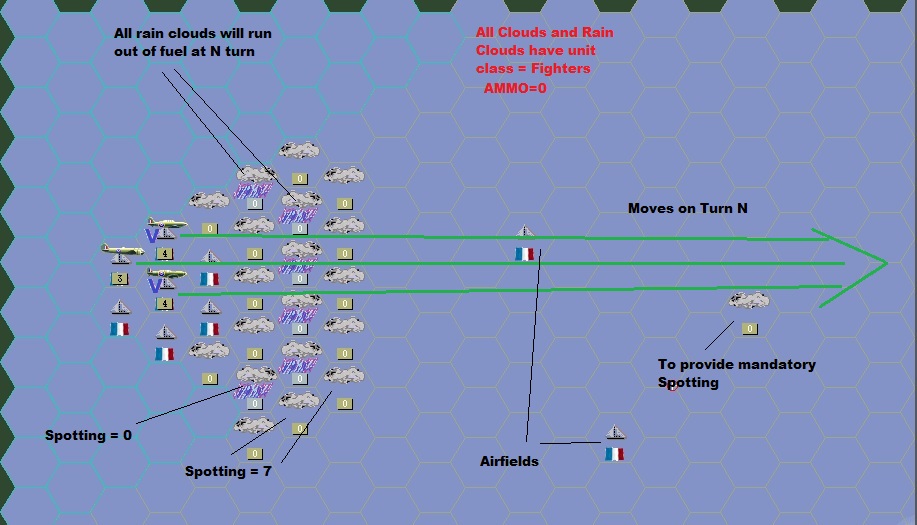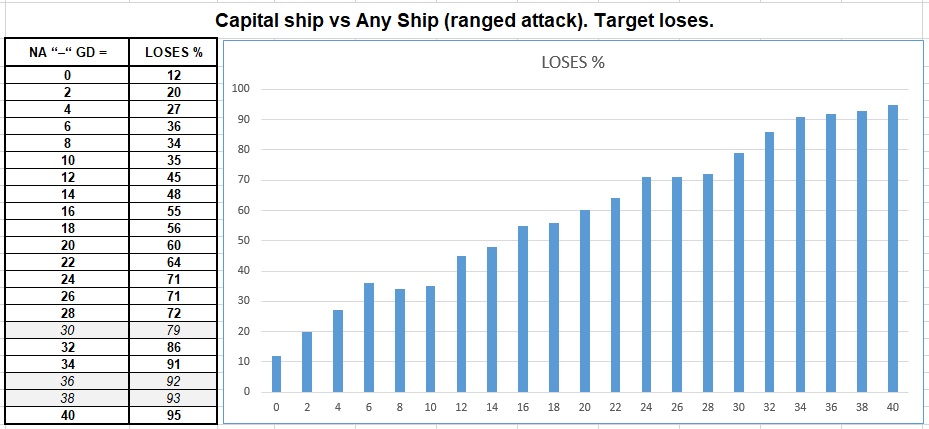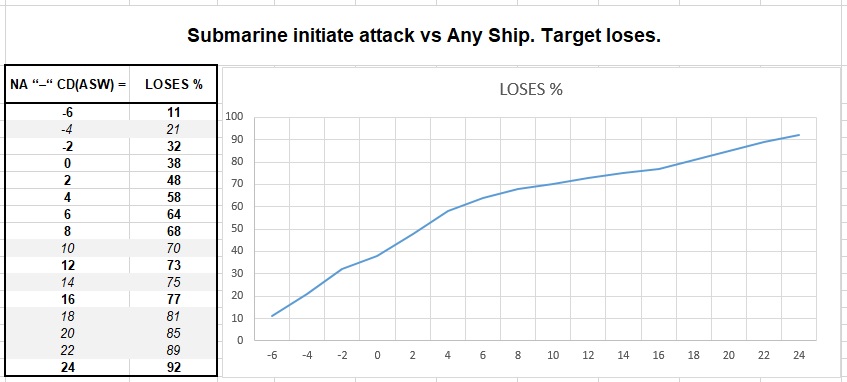Nothing radically new.
Flak 8.8 AA=15.
Wirbelwind AA=9 (reduced from 11)
Level Bombers maximum GD increased to 25.

Moderator: Radoye

Certainly this option is relevant!HexCode wrote: ↑2024-02-05 18:08, Monday TEMPORARY APPEARANCE...
On rare occasions, content designers have resorted to undercapacitating a unit's ammo by specifying Starting Ammo Points (SAPs) less than the unit's Listed Ammo Capacity (LAC).
For the purposes of THIS post, it's still assumed that BOTH SAP and LAC values are POSITIVE.
Is the Feature Relevant to Custom Content Design ?
This is another interesting question. On the face of it, ammo undercapacitation does saddle a unit with a fighting disadvantage. For how long, though ? Resupply / Replacements Procurement significantly ameliorates, even nullifies, the disadvantage.
I can think of the following special situation. At the very start of a scenario, an undercapacitated unit finds itself "tightly" surrounded by enemy units. To this effect, Resupply / Replacements Procurement is practically impossible. Similarly, retreating to safety so as to procure Resupply / Replacements "in peace" isn't a viable option. The unit must keep on fighting until it runs out of ammo. Once that happens, the enemy's chances of destroying the unit increase significantly. A most interesting situation arises when a super-resilient (as per Listed Attributes) unit runs out of ammo while being surrounded by significantly weaker (as per Listed Attributes) enemy units taking successive potshots at it. Listed strength / resilience is compromised by Situational vulnerability.
Sure, Organic, Air and Sea transports.


For me too!HexCode wrote: ↑2024-02-07 02:06, Wednesday
Once a content designer utilizes negative integers, he finds himself squarely in "design-for-effect" territory.
<...>
In a nutshell, the unit keeps on shooting without being afraid of running out of ammo. It can still Resupply with or without Replacements Procurement without losing the benefit of negative AP values. Moreover, it doesn't have to worry about any adverse effects on its APs due to Carpet Bombing. Sounds like a dream weapon to me...
Unfortunately, the species affiliation of such a creature is unclear.
Or capturing a remote location somewhere far away. At the start of the Stand-alone scenario, the player has only units with small LFC. Some units have Fuel Overcapacitation. Not all of them can reach the remote objective. The task of the starting combat is to conduct it in such a way that units with Fuel Overcapacitation remain unharmed to fulfill the main objective.
Brave Air Aces.HexCode wrote: ↑2024-02-09 02:44, Friday B) Units less likely to incur serious SF losses for awhile due to their superior attack and defense capabilities (e.g., super-armor, super-fighters).
C) Units assigned missions requiring them to keep on fighting without respite no matter what. Such missions could be suicidal or, in the case of sufficiently Overstrengthened units, relatively unstoppable walkovers.
HexCode has pre-set the conditions for testing, and rightly so. We have to start somewhere!SUBMARINE CLASS UNIT DETECTION viewtopic.php?f=100&t=543#p11016
SUBMARINE CLASS UNIT EVASION (Part I) viewtopic.php?f=100&t=543#p11394
SUBMARINE CLASS UNIT EVASION (Part II) viewtopic.php?f=100&t=543#p11395
Let's try to figure out what's in the deeps.Caveats: It is assumed that Unit Strength, Experience and Weather Conditions do NOT affect Evasion chances...
Good point!
Lettos wrote: Conclusion: If Submarine attacks Capital Ship or Air Carrier they will have Ground Defense = 0. WRONG!
Lettos, find out information, experiment with Close Defense, and the conclusions will be different!
If Submarine initiates attack vs Destroyer, Destroyer Close Defense parameter used!Lettos wrote: penalty to Submarine Naval Attack in case of a destroyer attack is "minus 6". WRONG!
[Alt+Click] - It's not working for me for some reason. It shows the unit's characteristics. My laptop glitch?HexCode wrote: ↑2024-02-11 20:46, Sunday [Ctrl+Click] ==> Extended Combat Prediction
[Alt+Click] ==> Last Combat Log
The first Hot Key addresses an envisaged player's desire (yeah, right) to know some details as to whether a contemplated attack of his is likely to produce (or not) positive results.
It's the second Hot Key which "reveals" details regarding the outcomes of some specific attack. It's the closest to what one might find in a traditional, technical manual (such manuals simply don't exist in SSI's "World"... Hence, an "outsider's" need for some... Library !)
Of course, there's absolutely no guarantee the depicted mechanics accurately reflect the underlying programming...
That's great! I saw this name in eqpedit and didn't understand - what does it mean? Live and learn forever!
If Destroyer attacks a submarine, Submarine will use their Ground Defense parameter.Lettos wrote: If a destroyer attacks a submarine, the destroyer gets a "minus 6" penalty to its Naval Attack. WRONG!
Works!





Hi HexCode!HexCode wrote: ↑2024-02-13 03:29, Tuesday This is yet another interesting question. On the face of it, Fuel Undercapacitation does saddle a unit with an indirect fighting disadvantage. For how long, though ? Resupply / Replacements Procurement significantly ameliorates, even nullifies, the disadvantage.
Situations might arise where a scenario designer wishes for some unit not to be able to race full throttle towards some important map location or, equally, away from it. If so, the unit might be forced to momentarily stop and trigger (if situationally feasible) Resupply / Replacements Procurement.

In responding, I was somehow only thinking of land units. But there are air units too!

Yeah, you're right. Player's Air Transports with unlimited FUEL is something wrong. But we can leave zero fuel values for AI Air transports.HexCode wrote: ↑2024-02-13 19:17, Tuesday This topic comes up in modding discussions from time to time. In the very distant past (i.e., PG1-DOS), lively debates were taking place about SSI's content design choice to render Air Xport Class units "operationally agnostic" regarding FP availability constraints... Personally, I feel a bit uncomfortable when it comes to unit Types which, despite obvious, important representation realities, are nevertheless rendered "operationally agnostic".
I'll tell you right away - without additional tuning and some other simple tricks, there is no balance in these duels, neither with those parameters vanilla set in Panzer General and then cloned in PGF, nor in these new parameters.Parameters:
Destroyer ------ NA = 18 --- GD = 3 ---- INI = 3
Light Cruiser -- NA = 22 --- GD = 8 ---- INI = 4
Heavy Cruiser - NA = 28 --- GD = 16 --- INI = 5
Battleship ------ NA = 36 --- GD = 22 --- INI = 7
That being said, I have additional requests:After familiarizing myself with a mass of material on the armament and combat tactics of ships, I adopted as a working version following combat rating :
Destroyer = measurement unit
Light Cruiser = 2 Destroyers
Heavy Cruiser = 2 Light Cruisers = 4 Destroyers
Battleship = 2 Heavy Cruisers = 4 Light Cruisers = 8 Destroyers
Torpedo boat not investigated for now. Sure, something weaker than Destroyer.
Battle Cruiser, Pocket Battleship -sure, somewhere between Battleship and Heavy Cruiser as it exist now in any eqp.
Yeah, I had the thought of putting some ports on the map and putting some negative SFP ships in them. Do a delayed start. Have to check if these ships will stay in the ports even when they get their full LFP.HexCode wrote: ↑2024-02-17 04:55, Saturday B) Naval units cannot EVER move unless they are in a friendly port, in which case (barring multiple enemy target unit adjacency), their FPs will eventually revert to LFC status.
A content designer may place such units on the map with the clear understanding that the units will NEVER move. Of course, placing such units in a friendly port technically enables the designer to delay their eventual departure.
Yes, this is by far the most basic, and also proven use of negative SFP.



I have increased the STR of the units being attacked (assumed AI opponent) from "14" to "16". While at equilibrium there were 19-20 victories in thirty test battles, after increasing STR out of 30 battles the attacking side (player) won only four.Lettos wrote: ↑2024-02-17 13:41, Saturday And now that you have a fine instrument in your hands, you can start unbalancing it in different directions and see what you get. What is the effect of reducing EXP by at least 100, what happens if you increase STR from 14 to 15-17. You can work comfortably!
